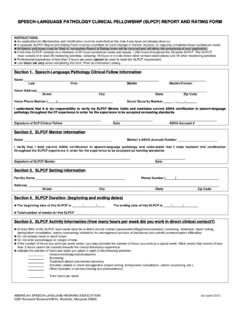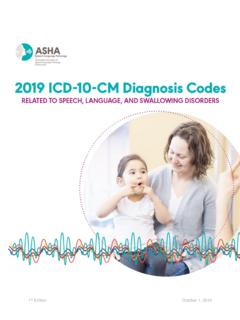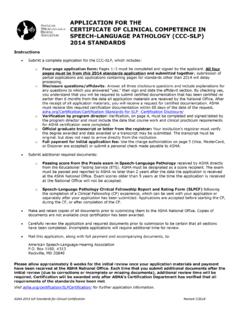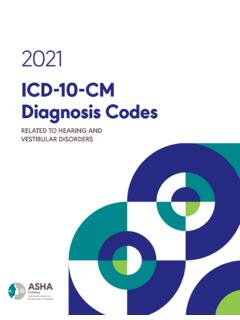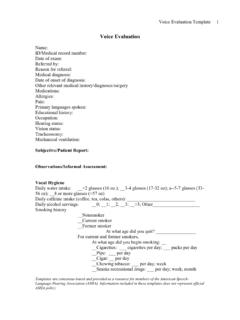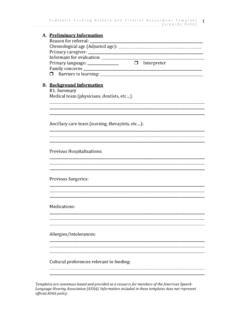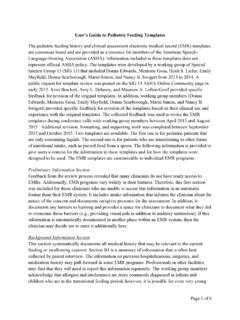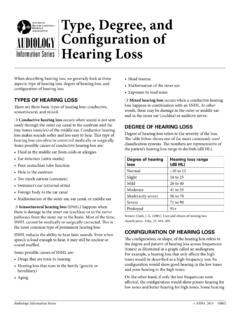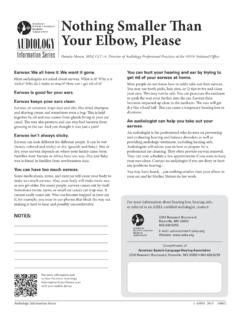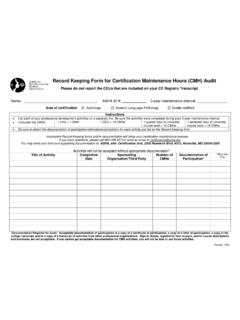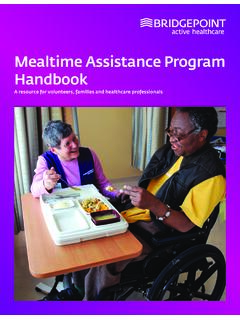Transcription of Speech-Language Pathology Medical Review Guidelines
1 Speech-Language Pathology Medical Review Guidelines American Speech-Language -Hearing Association Speech-Language Pathology Medical Review Guidelines American Speech-Language -Hearing Association General Information The Speech-Language Pathology Medical Review Guidelines , published by the American Speech-Language -Hearing Association (ASHA), were developed by the 2008 Ad Hoc Committee on Speech-Language Pathology Medical Review Guidelines , consisting of ASHA-certified speech- language pathologists Becky Cornett (chair), Diane Ross, Lynne F. Harmon, Gretchen Bebb, and Pat Ford, who developed this document in conjunction with Janet McCarty, private health plans advisor, and Neela Swanson, health care financing information coordinator. Vice President for Government Relations & Public Policy Thomas J. Hallahan served as the Board of Directors liaison and monitoring officer for the committee and Director of Health Care Economics and Advocacy Steven C.
2 White served as consultant. Information in this publication continues to be updated by ASHA's Health Care Economics &. Advocacy Team on an as-needed basis. Copies may be obtained as follows: online: e-mail: phone: 800-498-2071 (ask to speak to a member of the Health Care Economics &. Advocacy Team). Copyright 2015 American Speech-Language -Hearing Association Table of Contents Section 1. Introduction .. 3. Definition of Speech-Language Pathology .. 4. Etiologies .. 4. Assessment, Diagnosis, Treatment, Referral .. 4. Speech-Language Pathology Providers .. 6. ASHA Certification .. 6. Clinical Documentation .. 6. Types of 7. Medical Necessity of Speech-Language Pathology Services .. 8. Why Speech-Language Pathology Services Meet the Definition of Medical Necessity .. 10. ASHA's Treatment Efficacy 10. Prevalence and Incidence of Communication and Swallowing Disorders At-a- Glance.
3 10. Definition of a Communication Disorder .. 12. Clinical Coverage Concepts .. 12. Habilitative Services .. 12. Rehabilitative Services .. 12. Developmental Conditions .. 12. Group Treatment .. 13. Maintenance 13. Section 14. Speech-Language Pathology Treatments and Procedures .. 16. Augmentative and Alternative Communication/Speech-Generating Devices .. 16. Audiologic Rehabilitation or Auditory Rehabilitation (See also Hearing Disorder).. 18. (Central) Auditory Processing Treatment (See also (Central) Auditory Processing Disorder) .. 18. Cognitive-Communication Treatment (Cognitive Deficits, Cognitive Rehabilitation; See also Cognitive-Communication Disorder) .. 19. Fluency Treatment (Stuttering, Cluttering; See also Stuttering and Cluttering Disorder) .. 19. language Treatment (Receptive, Expressive, Pragmatics or Social Communication, Reading, Writing; See also language Disorder).
4 20. Myofunctional Treatment (Tongue Thrust; See also Myofunctional Disorder) .. 21. Myofunctional disorder is a disorder of tongue and lip posture and movement. Treatment focuses on mod .. 21. Neurological Motor-Speech Treatment .. 21. Social Communication Treatment (See also language Treatment, Social Communication Disorder) .. 22. Speech Sound Disorders Treatment (Articulation Disorder Treatment, Phonological Process Disorder Treatment) .. 22. Swallowing Treatment (See also Dysphagia, Swallowing Disorder) .. 23. Voice and/or Resonance Treatment (See also Voice and/or Resonance Disorder).. 26. Section 31. Speech-Language Pathology Diagnoses & Related Medical Conditions .. 33. Amyotrophic Lateral Sclerosis (ALS) .. 33. Aphasia .. 33. Apraxia (Including Childhood Apraxia of Speech).. 34. Autism Spectrum Disorder .. 35. (Central) Auditory Processing Disorder [See also (Central) Auditory Processing Treatment].
5 36. Cerebral 37. Cleft Lip and Palate .. 37. Cognitive-Communication Disorder (Cognitive Deficits, Cognitive Rehabilitation;. See also Cognitive-Communication Treatment, Traumatic Brain Injury) .. 39. 39. Dysarthria .. 40. Dysphagia (Swallowing Disorder), Adult and Pediatric (See also Swallowing Treatment) .. 41. Head and Neck Cancer .. 41. Hearing Disorder .. 42. language Disorder (Spoken language Comprehension and Expression, Pragmatics or Social Communication; See also language Treatment) .. 43. 44. Multiple Sclerosis .. 45. Myofunctional Disorder (Tongue Thrust; See also Myofunctional Treatment) .. 46. Neurological Motor Speech Disorder (See also Neurological Motor Speech Treatment, Apraxia, Dysarthria) .. 46. Paradoxical Vocal Fold Motion Disorder .. 47. Parkinson's Disease .. 47. Social Communication Disorder (See also language Disorder, language Treatment).
6 48. Speech Sound Disorders (Articulation Disorder, Phonological Process Disorder;. See also Speech Sound Disorders Treatment) .. 48. Stuttering and Cluttering Disorder (See also Fluency Treatment) .. 48. Traumatic Brain Injury (Cognitive Deficit, Cognitive Rehabilitation; See also Cognitive-Communication Disorder, Cognitive-Communication Treatment) .. 49. Velopharyngeal Dysfunction (See also Cleft Lip and Palate, Voice and/or Resonance Treatment, Voice and/or Resonance Disorder) .. 50. Voice and/or Resonance Disorder (See also Velopharyngeal Dysfunction, Cleft Lip and Palate, Voice and/or Resonance Treatment; Laryngectomy) .. 51. Section IV .. 53. Speech-Language Pathology 55. Dysphagia Instrumental Assessment .. 55. Electrolarynx .. 56. Laryngeal Function Studies .. 56. Velopharyngeal Dysfunction Instrumental Assessment .. 56. Videostroboscopy.
7 57. Speech-Language Pathology Prosthetics .. 57. Tracheoesophageal Prosthesis (TEP) .. 57. Tracheostomy Speaking Valves .. 58. Cochlear Implants .. 58. Laryngeal Implants .. 59. Section V .. 61. Applicable Billing Codes: CPT, ICD-10-CM, HCPCS Codes .. 62. Current Procedural Terminology (CPT) .. 62. International Classification of Diseases, 10th Revision, Clinical Modification (ICD- 10-CM) .. 64. Health Care Procedure Coding System National (HCPCS) Level II Codes .. 64. Section VI .. 68. Section I. Overview Speech-Language Pathology Medical Review Guidelines 1. Speech-Language Pathology Medical Review Guidelines 2. Introduction The purpose of the Medical Review Guidelines for Speech-Language Pathology is to serve as a resource for health plans to use in all facets of claims Review and policy development. The Guidelines provide an overview of the profession of Speech-Language Pathology including Speech-Language pathologist qualifications, standard practices, descriptions of services, documentation of services, and treatment efficacy data.
8 The American Speech-Language -Hearing Association (ASHA) is the national professional, scientific, and credentialing association for more than 182,000 members and affiliates who are audiologists; Speech-Language pathologists; speech, language , and hearing scientists; audiology and Speech-Language Pathology support personnel; and students in the fields of speech, language , and hearing. Speech-Language Pathology is the profession that provides clinical services and undertakes prevention, advocacy, education, administration, and research in the areas of communication and swallowing across the life span, from infancy through the geriatric stage. Speech-Language Pathology Medical Review Guidelines 3. Definition of Speech-Language Pathology Speech-Language Pathology services are those services necessary for the diagnosis and treatment of swallowing (dysphagia), Speech-Language , and cognitive-communication disorders that result in communication disabilities.
9 Speech-Language pathologists treat disorders of speech sound production ( , articulation, apraxia, dysarthria), resonance ( , hypernasality, hyponasality), voice ( , phonation quality, pitch, respiration), fluency ( , stuttering), language ( , comprehension, expression, pragmatics, semantics, syntax), cognition ( , attention, memory, problem solving, executive functioning), and feeding and swallowing ( , oral, pharyngeal, and esophageal stages). (ASHA, 2007a). Etiologies Potential etiologies of communication and swallowing disorders include: neonatal problems ( , prematurity, low birth weight, substance exposure). developmental disabilities ( , specific language impairment, autism spectrum disorder, dyslexia, attention deficit/hyperactive disorder). auditory problems ( , hearing loss or deafness, central auditory processing disorders). oral anomalies ( , cleft lip/palate, dental malocclusion, macroglossia, oral-motor dysfunction).
10 Respiratory compromise ( , bronchopulmonary dysplasia, chronic obstructive pulmonary disease). pharyngeal anomalies ( , upper airway obstruction, velopharyngeal insufficiency/incompetence). laryngeal anomalies ( , vocal fold Pathology , tracheal stenosis, tracheostomy). neurological disease/dysfunction ( , traumatic brain injury, cerebral palsy, cerebral vascular accident, dementia, Parkinson's disease, amyotrophic lateral sclerosis). psychiatric disorder ( , psychosis, schizophrenia). genetic disorders ( , Down syndrome, fragile X syndrome, Rett syndrome, velocardiofacial syndrome). Further detail is provided in ASHA's Scope of Practice in Speech-Language Pathology on the ASHA Website at Assessment, Diagnosis, Treatment, Referral Speech-Language Pathology services can be grouped into two main categories: 1) diagnostic or evaluative services and 2) therapeutic services.
